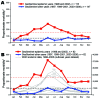Seasonality, annual trends, and characteristics of dengue among ill returned travelers, 1997-2006
- PMID: 18598629
- PMCID: PMC2600332
- DOI: 10.3201/eid1407.071412
Seasonality, annual trends, and characteristics of dengue among ill returned travelers, 1997-2006
Abstract
We examined seasonality and annual trends for dengue cases among 522 returned travelers reported to the international GeoSentinel Surveillance Network. Dengue cases showed region-specific peaks for Southeast Asia (June, September), South Central Asia (October), South America (March), and the Caribbean (August, October). Travel-related dengue exhibited annual oscillations with several epidemics occurring during the study period. In Southeast Asia, annual proportionate morbidity increased from 50 dengue cases per 1,000 ill returned travelers in nonepidemic years to an average of 159 cases per 1,000 travelers during epidemic years. Dengue can thus be added to the list of diseases for which pretravel advice should include information on relative risk according to season. Also, dengue cases detected at atypical times in sentinel travelers may inform the international community of the onset of epidemic activity in specific areas.
Figures



References
-
- Jelinek T, Mühlberger N, Harms G, Corachán M, Grobusch MP, Knobloch J, et al. European Network on Imported Infectious Disease Surveillance. Epidemiology and clinical features of imported dengue fever in Europe: sentinel surveillance data from TropNetEurop. Clin Infect Dis. 2002;35:1047–52. 10.1086/342906 - DOI - PubMed
Publication types
MeSH terms
Grants and funding
LinkOut - more resources
Full Text Sources
Medical
